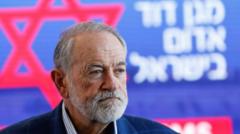**A NATO summit set against the backdrop of escalating tensions highlights the organization's internal divisions over defense spending and geopolitical crises.**
**NATO Summit Faces Internal Tensions Amid External Conflicts**

**NATO Summit Faces Internal Tensions Amid External Conflicts**
**Expectations low as defense spending disputes and Middle East tensions loom over The Hague meetings.**
In a critical gathering starting Tuesday in The Hague, NATO leaders will convene amidst significant global turmoil, including a brewing conflict in the Middle East and ongoing disturbances in Ukraine. A fragile cease-fire between Israel and Iran, announced by President Trump just before the summit, is likely to be the focal point of discussions. However, the situation in Ukraine—a pressing concern for many NATO members—may only receive scant attention.
The primary task for the alliance will be to present a unified front, particularly as discussions surrounding defense spending have caused notable friction among member states. This summit will occur against the shadow of President Trump’s controversial stance towards Ukraine, further complicating the atmosphere.
Liana Fix, a political expert at the Council on Foreign Relations, posited that the recent developments in Iran might serve as a distraction from NATO members' disagreements. “Ironically, this situation could bolster cohesion at the summit,” Fix stated, suggesting that Trump's initiative in the Middle East may play into a larger narrative of American leadership.
However, NATO’s secretary general, Mark Rutte, faces challenges in ensuring a smooth, productive meeting. His efforts to address internal disputes over funding while keeping the dialogue focused on unity may prove troublesome, particularly as many member states express frustration over differing commitments to defense spending.
With the summit set to conclude on Wednesday, decisions and announcements made during this period could set significant precedents for the future of NATO, especially in the wake of increasing global tensions. As the meeting unfolds, the effectiveness of NATO in tackling both its internal challenges and external threats will be closely scrutinized.
The primary task for the alliance will be to present a unified front, particularly as discussions surrounding defense spending have caused notable friction among member states. This summit will occur against the shadow of President Trump’s controversial stance towards Ukraine, further complicating the atmosphere.
Liana Fix, a political expert at the Council on Foreign Relations, posited that the recent developments in Iran might serve as a distraction from NATO members' disagreements. “Ironically, this situation could bolster cohesion at the summit,” Fix stated, suggesting that Trump's initiative in the Middle East may play into a larger narrative of American leadership.
However, NATO’s secretary general, Mark Rutte, faces challenges in ensuring a smooth, productive meeting. His efforts to address internal disputes over funding while keeping the dialogue focused on unity may prove troublesome, particularly as many member states express frustration over differing commitments to defense spending.
With the summit set to conclude on Wednesday, decisions and announcements made during this period could set significant precedents for the future of NATO, especially in the wake of increasing global tensions. As the meeting unfolds, the effectiveness of NATO in tackling both its internal challenges and external threats will be closely scrutinized.





















